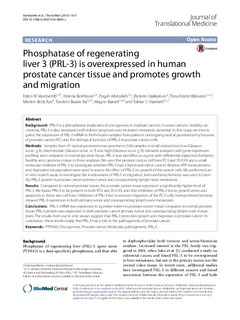| dc.contributor.author | Vandsemb, Esten Nymoen | |
| dc.contributor.author | Bertilsson, Helena | |
| dc.contributor.author | Abdollahi, Pegah | |
| dc.contributor.author | Størkersen, Øystein | |
| dc.contributor.author | Våtsveen, Thea Kristin | |
| dc.contributor.author | Rye, Morten Beck | |
| dc.contributor.author | Rø, Torstein Baade | |
| dc.contributor.author | Børset, Magne | |
| dc.contributor.author | Slørdahl, Tobias Schmidt | |
| dc.date.accessioned | 2016-07-04T13:45:54Z | |
| dc.date.accessioned | 2016-07-05T09:06:06Z | |
| dc.date.available | 2016-07-04T13:45:54Z | |
| dc.date.available | 2016-07-05T09:06:06Z | |
| dc.date.issued | 2016 | |
| dc.identifier.citation | Journal of Translational Medicine 2016, 14(1) | nb_NO |
| dc.identifier.issn | 1479-5876 | |
| dc.identifier.uri | http://hdl.handle.net/11250/2395602 | |
| dc.description.abstract | Background: PRL-3 is a phosphatase implicated in oncogenesis in multiple cancers. In some cancers, notably carcinomas, PRL-3 is also associated with inferior prognosis and increased metastatic potential. In this study we investigated the expression of PRL-3mRNA in fresh-frozen samples from patients undergoing radical prostatectomy because
of prostate cancer (PC) and the biological function of PRL-3 in prostate cancer cells.
Methods: Samples from 41 radical prostatectomy specimens (168 samples in total) divided into low (Gleason
score ≤ 6), intermediate (Gleason score = 7) and high (Gleason score ≥ 8) risk were analyzed with gene expression
profiling and compared to normal prostate tissue. PRL-3was identified as a gene with differential expression between
healthy and cancerous tissue in these analyses. We used the prostate cancer cell lines PC3 and DU145 and a small
molecular inhibitor of PRL-3 to investigate whether PRL-3 had a functional role in cancer. Relative ATP-measurement
and thymidine incorporation were used to assess the effect of PRL-3 on growth of the cancer cells. We performed an
in vitro scratch assay to investigate the involvement of PRL-3 in migration. Immunohistochemistry was used to identify PRL-3 protein in prostate cancer primary tumor and corresponding lymph node metastases.
Results: Compared to normal prostate tissue, the prostate cancer tissue expressed a significantly higher level of
PRL-3. We found PRL-3 to be present in both PC3 and DU145, and that inhibition of PRL-3 led to growth arrest and
apoptosis in these two cell lines. Inhibition of PRL-3 led to reduced migration of the PC3 cells. Immunohistochemistry
showed PRL-3 expression in both primary tumor and corresponding lymph node metastases.
Conclusions: PRL-3 mRNA was expressed to a greater extent in prostate cancer tissue compared to normal prostate
tissue. PRL-3 protein was expressed in both prostate cancer primary tumor and corresponding lymph node metastases. The results from our in vitro assays suggest that PRL-3 promotes growth and migration in prostate cancer. In
conclusion, these results imply that PRL-3 has a role in the pathogenesis of prostate cancer. | nb_NO |
| dc.language.iso | eng | nb_NO |
| dc.publisher | BioMed Central | nb_NO |
| dc.rights | Navngivelse 3.0 Norge | * |
| dc.rights.uri | http://creativecommons.org/licenses/by/3.0/no/ | * |
| dc.title | Phosphatase of regenerating liver 3 (PRL-3) is overexpressed in human prostate cancer tissue and promotes growth and migration | nb_NO |
| dc.type | Journal article | nb_NO |
| dc.type | Peer reviewed | nb_NO |
| dc.date.updated | 2016-07-04T13:45:53Z | |
| dc.source.volume | 14 | nb_NO |
| dc.source.journal | Journal of Translational Medicine | nb_NO |
| dc.source.issue | 1 | nb_NO |
| dc.identifier.doi | 10.1186/s12967-016-0830-z | |
| dc.identifier.cristin | 1355702 | |
| dc.description.localcode | This article is distributed under the terms of the Creative Commons Attribution 4.0 International License (http://creativecommons.org/licenses/by/4.0/), which permits unrestricted use, distribution, and reproduction in any medium, provided you give appropriate credit to the original author(s) and the source, provide a link to the Creative Commons license, and indicate if changes were made. The Creative Commons Public Domain Dedication waiver (http://creativecommons.org/publicdomain/zero/1.0/) applies to the data made available in this article, unless otherwise stated. | nb_NO |

